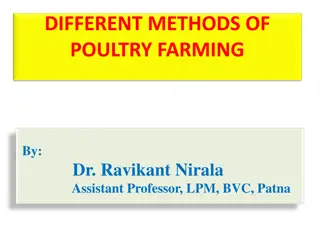Livestock-based Livelihoods and Farming Systems Evolution
Livestock-based livelihoods and farming systems have evolved over time, aiming to produce food and crops sustainably. Small-scale farming, farm management, types of farming, and various farming systems like specialized and diversified farming play key roles in enhancing productivity, profitability, and sustainability while ensuring resource preservation and environmental quality.
Download Presentation

Please find below an Image/Link to download the presentation.
The content on the website is provided AS IS for your information and personal use only. It may not be sold, licensed, or shared on other websites without obtaining consent from the author. Download presentation by click this link. If you encounter any issues during the download, it is possible that the publisher has removed the file from their server.
E N D
Presentation Transcript
UNIT-01 (LIVESTOCK BASED LIVELIHOODS AND THEIR EVOLUTION) Dr. Puspendra Kumar Singh Department of Veterinary & Animal Husbandry Extension Education, BVC
Farm: Farm is an area of land and its buildings which is used for growing crops and rearing animals. It is devoted primarily to agricultural processes with the primary objective of producing food and other crops. System: A system is a set of inter-related, interacting and interdependent elements acting together for a common purpose and capable of reacting as a whole to external stimuli.
FARMING SYSTEM: Farming system is an approach for developing farm household systems, built on the principles of productivity, profitability, stability and sustainability. The farming system approach emphasizes understanding of farm household, community inter linkages, reviews, constraints and assesses potentials and it combines improvements desired from better technology.
DEFINITION OF FARMING SYSTEM: Farming system is a decision making unit comprising the farm household, cropping and livestock system that transform land, capital and labour into useful products that can be consumed or sold (fresco and westphal, 1988) Farming system is a resource management strategy to achieve economic and sustained agricultural production to meet diverse requirements of farm livelihood while preserving resource base and maintaining a high level of environment quality (Lal and Miller 1990).
TYPES OF FARMING Types of farming can be defined as the farms in a group are a similar in the kind and proportions of the crops and livestock that produced and the methods followed in production. Specialized Farming
DIFFERENCE BETWEEN TYPES OF FARMING AND SYSTEM OF FARMING Types of Farming When farms in a group are quite similar in the proportions of the crops and livestock that are produced and the methods, production It is not related to ownership and operationship of farming Examples : specialized farming, diversified farming, farming, dry ranching etc. System of Farming Refers to the combination of products on a given farm and the methods or practices that are used in production of the product. kind and followed in It is related to ownership and operationship of farming Examples : Peasant farming, cooperative farming, capitalistic farming, collective farming and state farming etc. mixed and farming
Factors determining type of farming Physical factors: Climate Soil Topography Economic factors Relative Profitability Availability of funds Availability of labour & capital Availability of input Land values Marketing costs Marketing facilities Cycles of over & under production Competition between enterprises Personal choices Miscellaneous seasonal availability of raw material, diseases etc. Social factors: Type of community Cooperative spirit
Classification of farming Based on mode of ownership and organization of farms Individually owned Co-operative farming Collective farming Based on how income is derived from a farming enterprise Specialized farming Diversified farming Mixed farming Based on scale of operations Small scale farming Large scale farming
Specialized farming When a farm business unit derives more than of its 50 per cent income forms a single enterprise, known as specialized farming. Examples : paddy farming, sugarcane farming, tobacco farming, poultry farmers sheep farming etc. Why specialized farming ? assured income from the enterprise. its suitability to the area its relative
Advantages of specialized farming Best suited to particular soil, climate, topography & other physical conditions like market type Better utilization of land, Better marketing Better management Less equipments and labour needed Efficiency & skill of personnel increased Costly & efficient machinery can be kept Farmer can secure complete mastery over the conditions, problems of production, processing & sale Under favourable & specific conditions extremely profitable
Disadvantages Failure of crop, Non-utilization of productive resources Effect on soil health etc.
Large & Small scale farming Different means of describing scale of livestock enterprise: Quantity of produce & marketed unit within a time period Number of animals/ birds maintained Area of holding over which the livestock enterprise is based The advantages of large scale production over small scale production are called Economies of scale
Advantages of Large-scale farming Increased efficiency & full utilization of labour Lower machine cost as a result of greater annual use Building economics Buying and selling Management Economics in financing Economics in the use of by- products
Disadvantages of Large-scale farming Greater losses during depression period Difficulty in supervision Under utilization of resources, equipments, labors Apart from this, extended limit of farm then leads to inefficiencies
Advantages of small scale farming Close attention & supervision Efficient use of family labour Higher productivity Low market dependence for inputs Intensive cultivation is possible Social justice through distribution of landed property Higher family labour employment
Disadvantages of small scale farming Inadequacy of productive resources Unremunerative farming Limited scope for development Shortage of farm implements Under employment Market diseconomies Shortage of finance Relatively more overheads
Comparison between Large & Small scale farming Aspects Large scale Small scale Division of labour Possible Limited Mechanization Possible Not possible Quantity of output More Less Cost of production Low High Cost of management Low High Risk More Less Marketing facilities Better Poor Economy of buying & selling More Less Possibility of using improved technology More Less Danger of over production More Less Supervision Poor Better Flexibility Inflexible Flexible Chances of unhealthy competition More Less























